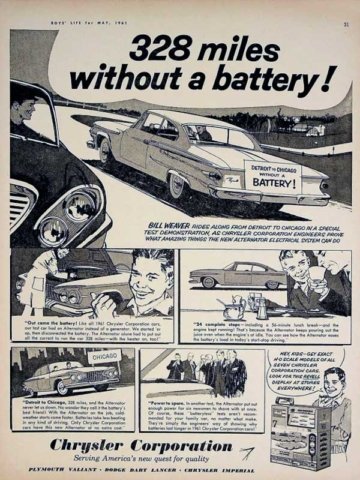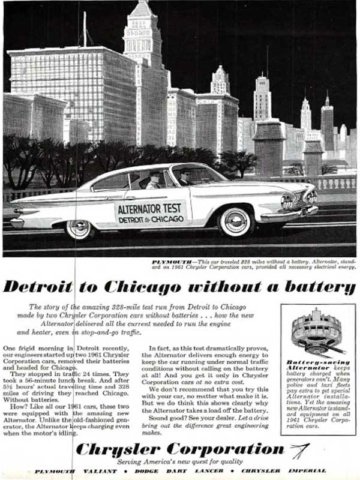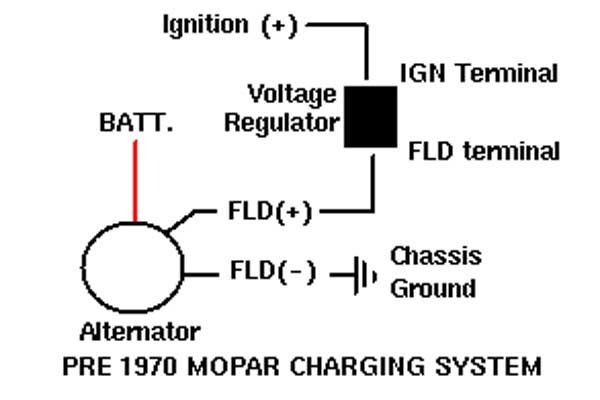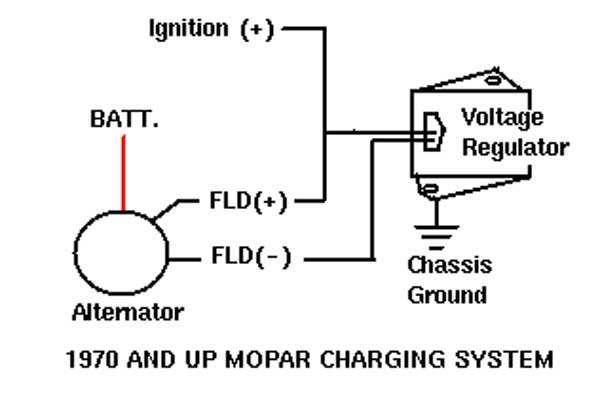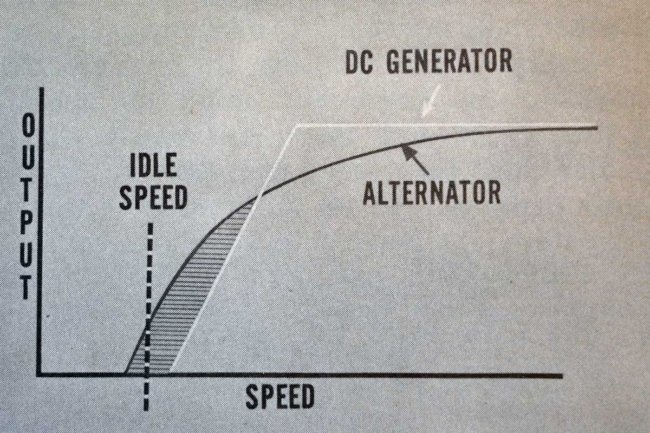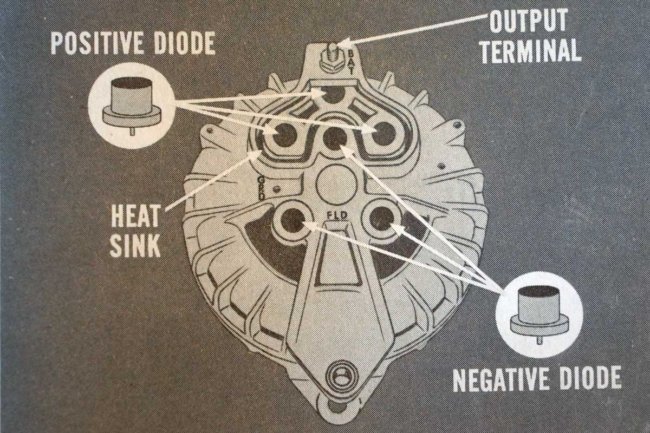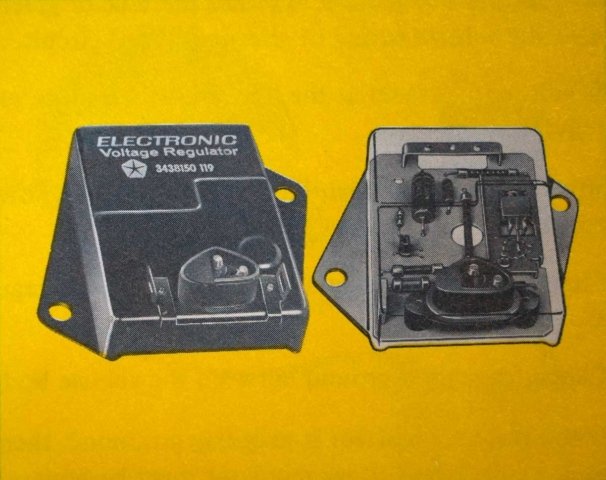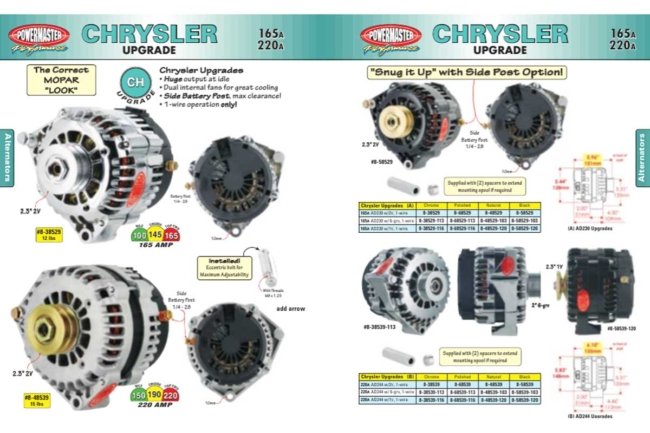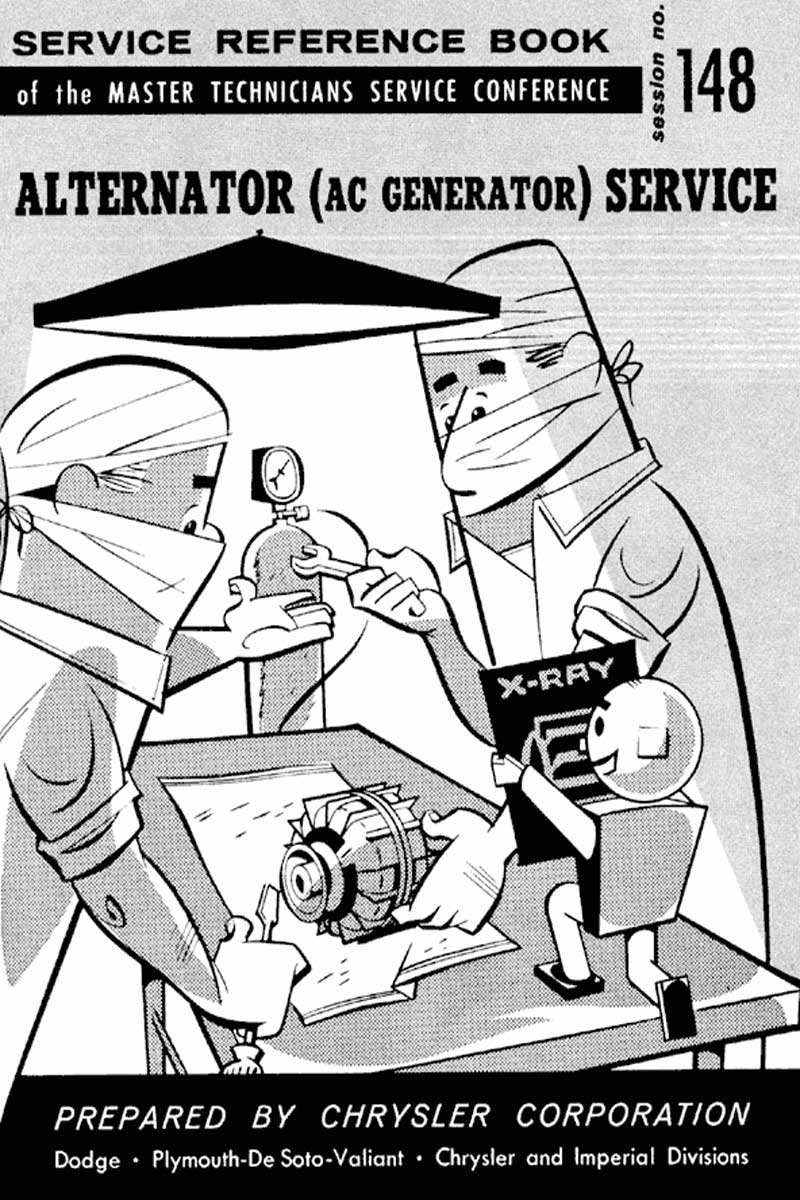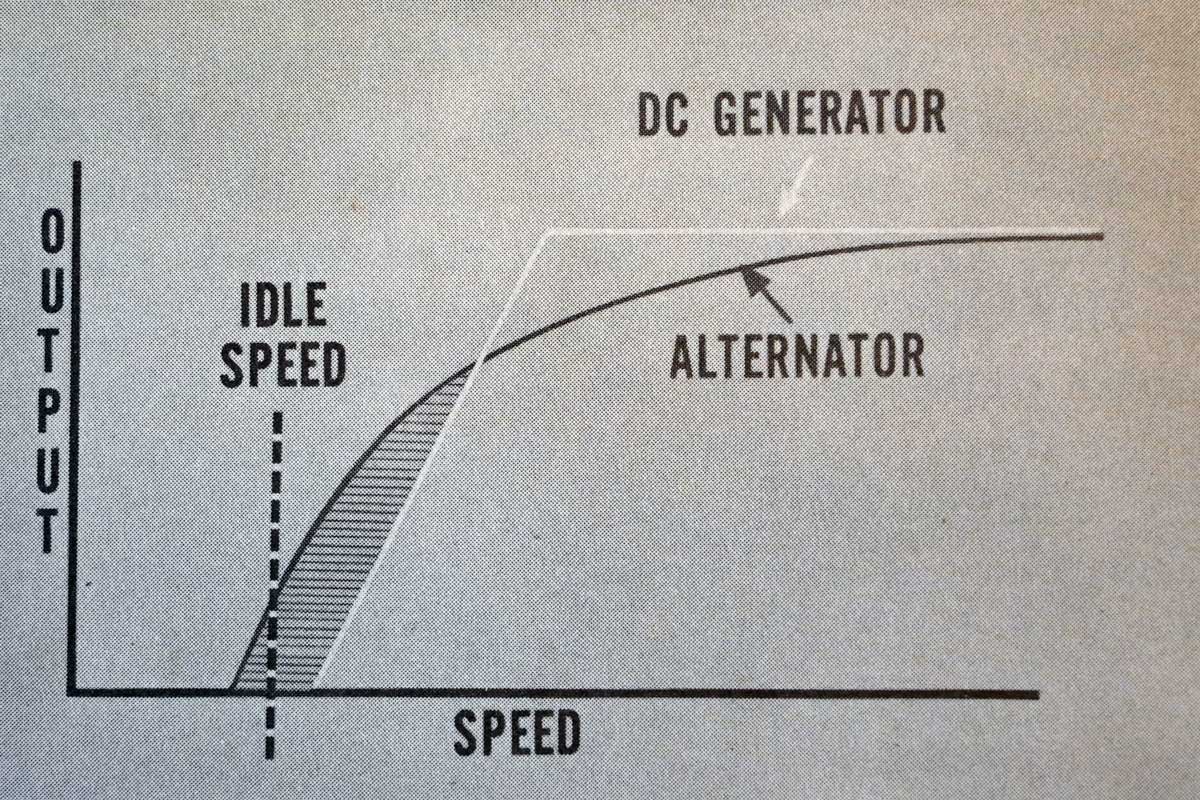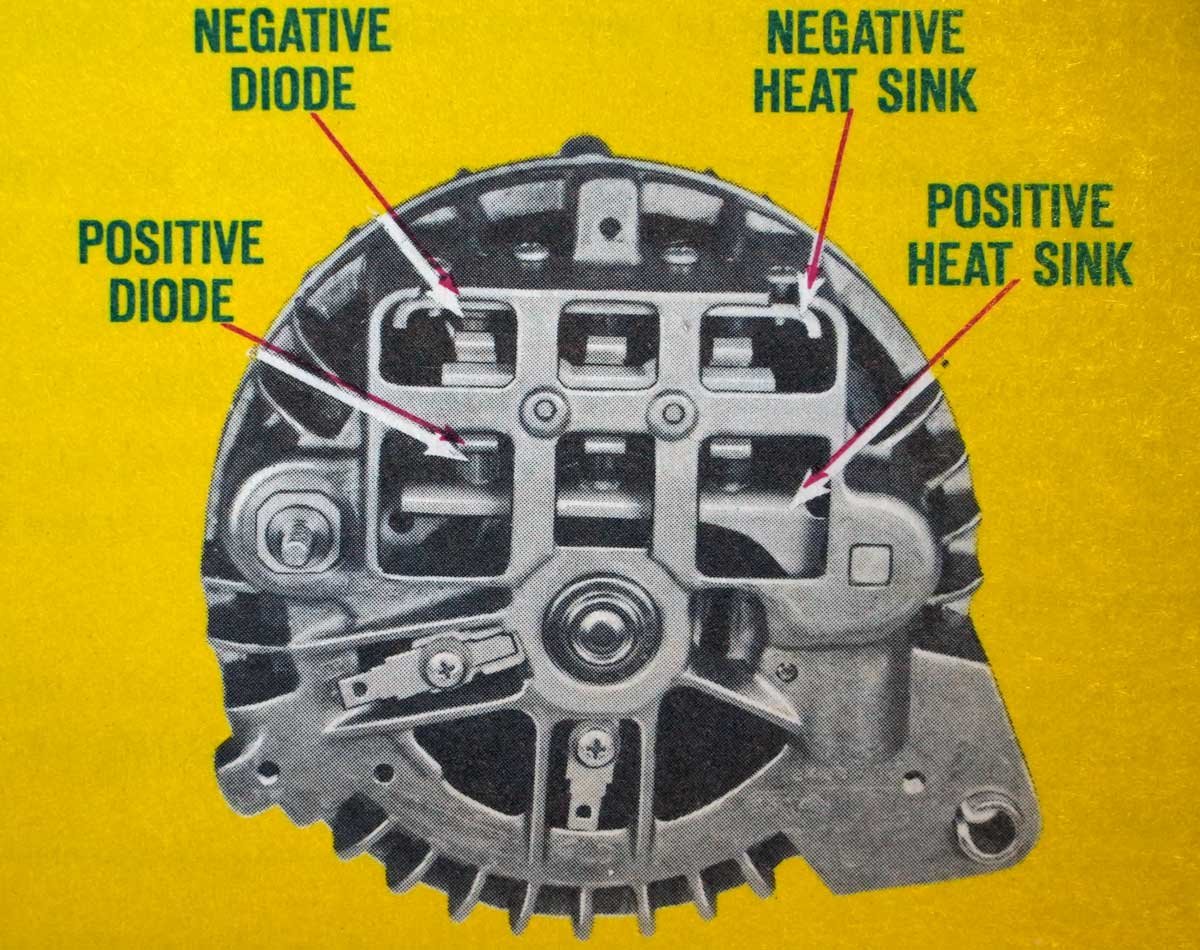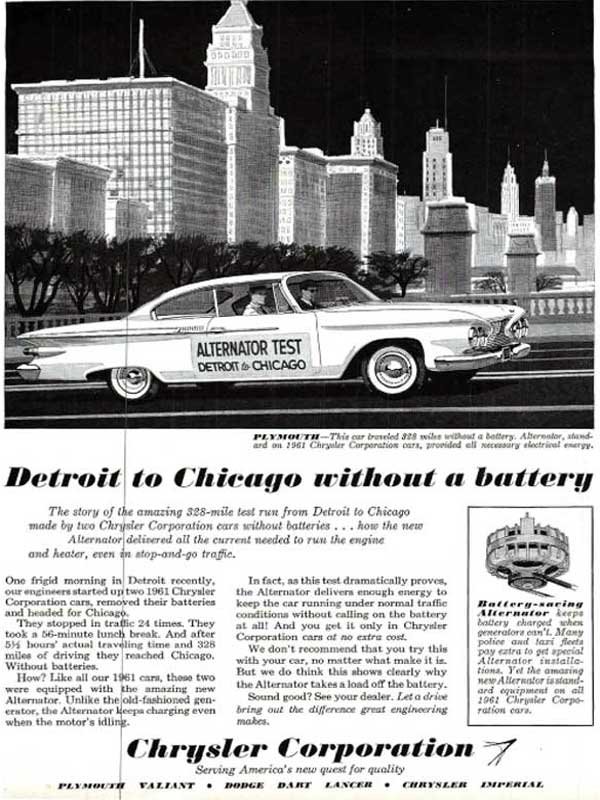
In 1960, the alternator (alternating current generator or AC generator) became a standard option on the Plymouth Valiant. Before alternators, cars used DC (direct current) generators (dynamos), which were less efficient, especially at low speeds.
Above Left: Chrysler ran an ad in Boys’ Life magazine in May 1961 about the battery-less test it had performed earlier in the year. The magazine advertisement and the Revell plastic model tie-in were great ways to attract youngsters to Chrysler products. Above Right: Chrysler also ran full-page ads in several automotive magazines, albeit in a more traditional advertising style.
The transition was a significant leap in automotive technology, as it marked the shift from less efficient DC generators to more powerful and efficient alternators. Soon after the Valiant, Chrysler became the first manufacturer to make the alternator standard equipment for all its models, including the Dodge Dart, Chrysler Newport, DeSoto Adventurer, and Imperial.
Above Left: Between 1961 and 1969, Chrysler products used an alternator with a B-circuit design. That meant the voltage regulator was wired “B”efore the field windings housed in the alternator. The regulator controlled the 12-volt side of the circuit. Above Right: With the introduction of its electronic voltage regulator (EVR), Chrysler switched to an A-circuit design. The voltage regulator was wired “A”fter the alternator housed field windings, and it controlled the ground side of the circuit. (Photos – www.bzerob.com)
So convinced were the Chrysler executives in the promise of the alternator that they approved a 328-mile drive from Detroit to Chicago with a pair of Chrysler Corporation vehicles without batteries. A comic-strip article in Boys’ Life magazine, May 1961, described the entire event process. Additionally, Revell revealed an opportunity for readers to purchase all seven Chrysler vehicles in 1/25th scale plastic.
Essex Wire Company played a pivotal role in the evolution of Chrysler alternators. It was the first to manufacture alternators for Chrysler products. The wide spacing of the fins on the front and rear frames and the Essex symbol cast into both frames could identify the Essex brand Chrysler alternator.
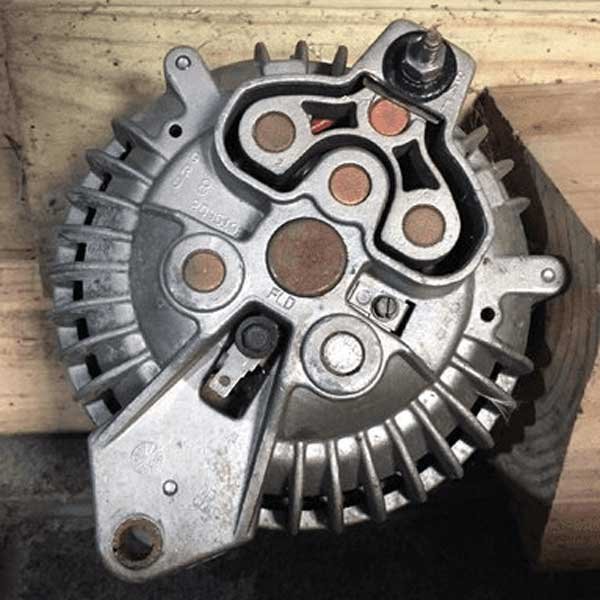
Above: The original Essex design that Chrysler replicated had a single field terminal that received voltage from the voltage regulator. There was not a second field wire but rather a screw that provided ground. The design was used until the end of the 1969 model year. The alternator design became known as the “round back.” (Photographer unknown)
An alternator is a three-phase AC generator that uses three positive and three negative diodes to convert the AC voltage to usable and storable DC voltage. All the can-type designed diodes are pressed into separate aluminum frames. When diodes operate (pass current), they produce heat, and the aluminum frames are excellent heat sinks to dissipate the heat.
Although solid-state electronic components, such as diodes, are powerful, they are also susceptible to heat and vibration damage, so heat control and vibration-free packaging are essential.

Above: Starting in 1970, Chrysler shifted to a two-field alternator. With the two-field design, the voltage entered one field terminal, passed through the field coil, and exited the second field terminal. From the second terminal, the voltage entered the EVR, which controlled the charging circuit by turning off and on the circuit’s ground. (Photographer Unknown)
Of the six diodes, three are negative diodes press-fitted into the alternator’s rear framework. The three positive diodes are pressed into an independent framework affixed to the rear frame connected to the B+ battery stud. A paper-thin mica insulator keeps the two electrically isolated.
Essex continued making Chrysler alternators through the 1963 model year, enhancing them by adding more fins to the frames to add strength. Essex also produced Chrysler’s first mechanical voltage regulators, each stamped with the Essex symbol into the metal case. The regulators were a single-field, B-circuit charging design.
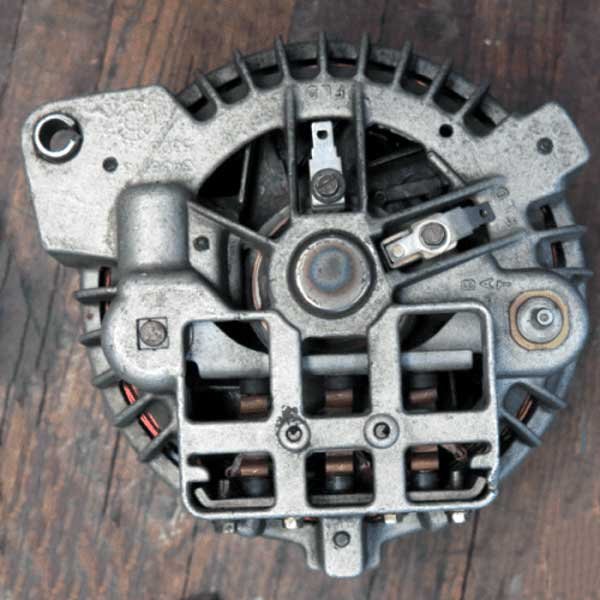
Above: In 1972, Chrysler significantly updated the alternator with the “square back” design. The diodes now resided on rectifiers. The alternator was more straightforward to service than the earlier units because the internal rectifiers and the stator windings were bolted together rather than soldiered. (Photographer Unknown)
In 1964, Chrysler began manufacturing alternators that significantly resembled the Essex alternators. However, the Chrysler alternators did not include the Essex emblem cast into the frames. Over the years, the alternators were produced in 30-, 37-, 46-, and 60-amp versions, and all looked the same from the outside.
Chrysler retained the same Essex B-circuit, single-field regulation design until the end of the 1969 model year. But, in 1970, Chrysler introduced its first electronic voltage regulator (EVR). The electronic regulator marked a significant shift in design, as the wiring changed from the single-field B-circuit alternator to the double-field A-circuit alternator.
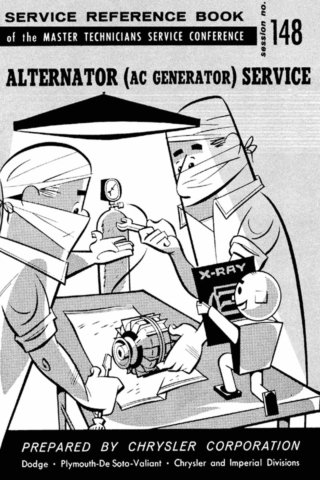
Above: The alternator was studied in one of Chrysler’s monthly Service Reference Books in March 1960. The multi-page 5×7-inch Alternator (AC Generator) Service booklet and film strip covered the charging system from its basics to advanced diagnostic test procedures. (Photo – Writer’s collection)
While the frame design of the A-circuit alternator remained the same as the pre-’69 alternator, Chrysler added another terminal for the second field. The production of the A-circuit style alternator continued for only two years. By 1972, Chrysler significantly redesigned the alternator. Although the front frame remained intact, the rear frame structure was quite different. The alternator was redesigned to improve its durability and heat dissipation.
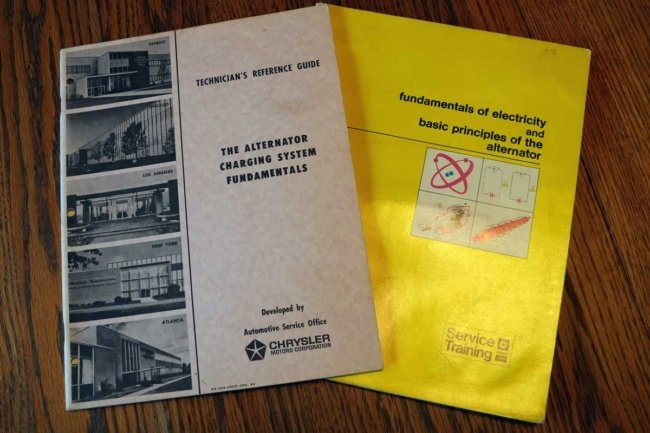
Above: Chrysler’s Automotive Service Office (later Service Training) published full-size booklets on the alternator charging system fundamentals. The books covered the charging system with mechanical voltage regulators (left – 1964) and later discussed the system operation with an EVR (right – 1972). (Photo – Writer’s collection)
Rather than the can-type pressed-in diodes, the new alternator had positive and negative rectifiers, each containing three diodes. These rectifiers were bolted to the rear frame (two separate assemblies), creating a shared electrical connection with the stator windings, which generate the electromagnetic field that induces the current in the rotor. Lastly, the newer alternator style significantly improved the repair procedures for rebuilders because of the solderless connections between the diodes and stator windings.
Above Left: A DC generator’s most significant disadvantage was its inability to charge the battery adequately during idle conditions. Conversely, the alternator (AC generator) could charge more efficiently at all engine RPMs while still charging at idle speed. Above Right: The original alternators had six can-type diodes (three positive and three negative) pressed into aluminum heat sinks. (Photos – The Alternator Charging System Fundamentals – Chrysler Motor Corporation)
The benefits of alternators include higher output at low engine speeds. Before alternators, generators produced DC power but were inefficient at low engine RPMs, meaning accessories dimmed or depleted at idle. Conversely, alternators convert AC power to DC, allowing for more substantial electrical output even at low RPMs.
Before alternators, generators could barely keep up with the electrical demands of headlights, radios, and basic electrical systems. After introducing alternators, which provided higher amperage, Chrysler could add power windows, seats, door locks, more efficient air conditioning systems, powerful headlights, and electrical accessories. By the late 1970s, alternators enabled the rise of high-output radios and more advanced automotive electronics.
Above Left: The square back alternator was introduced for the 1972 Chrysler models. It was a more technician-friendly design because it could be serviced more efficiently. Like previous alternators, three positive and three negative diodes were attached to rectifiers and heat sinks. Above Right: EVRs more precisely maintained the charging system voltage to keep the battery within the target voltage (13.5 – 14.8 volts). The EVRs were maintenance-free and required special testing equipment to verify their operation if a technician suspected a problem. (Photos – Fundamentals of Electricity and Basic Principles of the Alternator – Chrysler Training)
Unlike their successors, DC generators had brushes and commutators that wore out quickly and required frequent service. Alternators use slip rings and solid-state rectifiers to remedy the maintenance requirements. This design significantly reduces wear, making alternators more durable due to decreased maintenance necessities.
Above Left: Powermaster offers 95-amp original-look alternators in round and square back designs (catalog pages 102-103). Above Right: If high output amperage is desired, Powermaster steps up the amperage to as much as 200 amps (catalog pages 104-105).
By the 1970s and ‘80s, alternators had revolutionized the automotive industry. With more than a decade of technological advancements, alternators made it possible to shift to electronic fuel injection (EFI), replacing carburetors for better fuel economy, emissions compliance, and performance. The shift also led to the advent of onboard computers and sensors, leading to the modern ECU-controlled Mopars we enjoy today.
Powermaster Performance has been at the forefront of advancing charging technology for decades. Its alternators are highly regarded for their high output, durability, and custom applications for classic cars, muscle cars, hot rods, and racing vehicles. In addition to alternators, Powermaster offers high-quality charging system components. Powermaster voltage regulators and starters meet the diverse needs of automotive enthusiasts and professionals.
Above Left: Powermaster’s late-model alternators kick the amperage up to 220 amps (catalog pages 106-107). Above Right: Powermaster did not forget the AMC/Jeep owners. It has an array of alternators with up to 170 amps that fit several AMC/Jeep models and years (catalog pages 108-109).
Furthermore, Powermaster alternators deliver higher amperage than stock units, making them ideal for vehicles with high-performance stereos and audio systems, electric fans and water pumps, air conditioning and power accessories, and electronic fuel injection conversions.
Powermaster offers models with 95- to 220-amp output for street and race applications. Additionally, Powermaster sells 1-wire and externally regulated alternators in OEM-style housings, which look stock while providing modern performance.
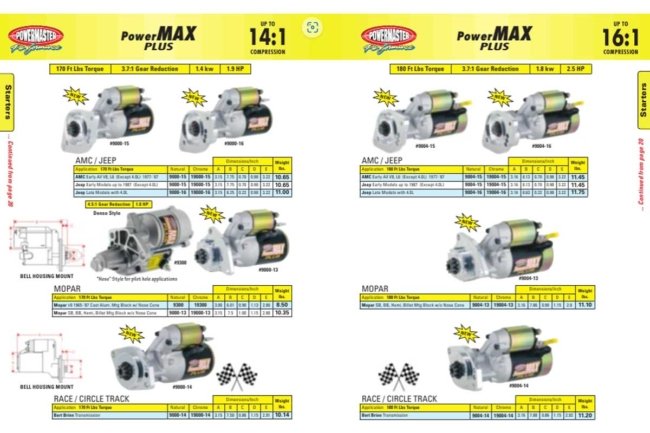
Above: Powermaster has starters for AMCs, Jeeps, small- and big-blocks, and race applications (catalog pages 110-111).
Each alternator has high-quality copper windings and heavy-duty diodes for better durability. Also, each comes with an overbuilt voltage regulator to prevent overcharging and protect sensitive electronics. Some alternators are built with billet aluminum cases, making them lightweight and strong.
For excellent low-RPM charging and durable and high-quality alternators designed as a custom-fit or direct replacement, look to Powermaster Performance to fill all your charging system needs.


